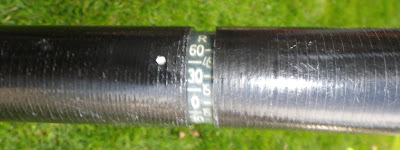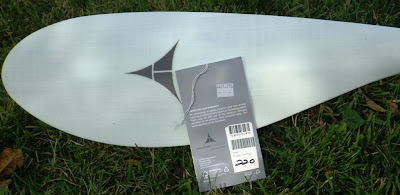Reduced Prices!
It's nearly the end of the paddling season and I have some of my gear to sell off. In particular, I have a few paddles and a spray skirt to sell. If you are interested in any of the below, give me a call at 306-370-3462, or leave a comment (I'll receive your comment via email quickly). Prices listed do not include shipping. If you are not local and want to get a quote on shipping, let me know where you are and we'll get a quote from FedEx and Canada Post.
The paddles are
Adventure Technology (AT) straight-shaft paddles. I have one with glass blades and 3 available with carbon fiber (graphite) blades. All of these paddles feature AT's "Synapse Ferrule" that allows the blade feather angle to be set in 15° increments from 0° to 60° (right or left) to find the perfect angle for you.
Quest Paddles (3) - 210 cm, 210 cm, 220 cm
The carbon fibre paddles are the
"Quest" model and are new this summer (mid-season). I have 2 Quest paddles for sale that are 210 cm and one that is 220 cm. These paddles retail for $230 locally. I am asking
$150 for the unused 210 cm paddle, and
$125 for the slightly used 210 cm and 220 cm paddles, all are in excellent condition. These are excellent good quality paddles that won't break the bank. My own pictures of these Quest paddles are below, as well as a description and specs from the AT Paddles website.
The Quest Carbon features a lightweight carbon construction and Full Control Grip on the shaft. The unique blade design is ideal for low angle paddling but is versatile enough for varying conditions and paddling styles because of its soft dihedral blade. In addition, the blade features a uniquely high fiber-to-resin ratio making it one of the most durable blades available anywhere.
- Weight: 29.5 oz/ 836 g
- Shaft: Carbon Fiberglass Blend, Standard Diameter
- Ferrule: Synapse Ferrule with SmartSet Technology
- Blade: 623 sq cm; Low Angle Design; Carbon; Reflective Logo
 |
| Unused paddle, still with the original tag and rubber band that they came from the store with. |
 |
| Synapse Ferrule is a spring loaded mechanism that allows the paddler to pull the joint apart and adjust the paddle feather in 15° increments. (I prefer 45° myself.) |
Odyssey Paddle (1) - 220 cm
The glass paddle is the
"Odyssey" model and is 220cm, was purchased at the start of last year and has seen 2 seasons of use in paddling lessons. It's in good condition. This paddle retails for $132 and I am asking for
$70. This is a good paddle that is a great savings over the much more expensive graphite paddles. The length at 220 cm is good for the average to tall person, paddling a kayak that is narrow to moderate width kayak (up to about 25", wider than that and you probably should look for a longer paddle). Again, the graphic, description and specs are from the AT website, the photos are my own.
The Odyssey Glass features a fiberglass shaft construction in both Full Control Grip and straight shaft. Its slightly larger blade is designed for more power without adding flutter. A great choice for those seeking easier rolling, additional stability, and better grip in the water.
- Weight: 38.0 oz/ 1077 g
- Shaft: Fiberglass, Standard Diameter
- Ferrule: Synapse Ferrule with SmartSet Technology
- Blade: 695 sq cm; Oversize Blade; Fiberglass
 |
| Assembled paddle with feather angle set to 45°. |
 |
| Top blade on the right shows the power face of the blade while the bottom blade on the left shows the backside of the blade. |
 |
| I even have the original tag for this paddle! |
Harmony Spray Skirt (1) - Large
I have a Harmony neoprene and nylon spray skirt for sale. This was my primary personal skirt last season before I upgraded to an all-neoprene (more watertight) skirt. It features nylon tunnel for comfort, and a deck perimeter made of neoprene to allow it to stretch and fit a variety of boats. It has two pockets in the deck, perfect for a few survival items (in case you wash up on shore without your boat), a small waterproof camera, or some snacks. Velcro at the waist allows you to adjust the skirt to fit your waist. This skirt retails for around $100 and I am asking $40. The condition is OK, there's definitely some wear and tear from rescue practice and use (see the photos).
 |
| Shown on a Swift Saranac with a 16.5 x 31" cockpit. This skirt also fits my WS Tempest 180 Pro with a 20" x 36" cockpit, though it's pretty tough to get on. I would suggest a cockpit of 35" or less is better for this skirt. |
 |
| The joint at the back of the rand is starting to come loose. Repair with a stitching awl may be necessary. |

















